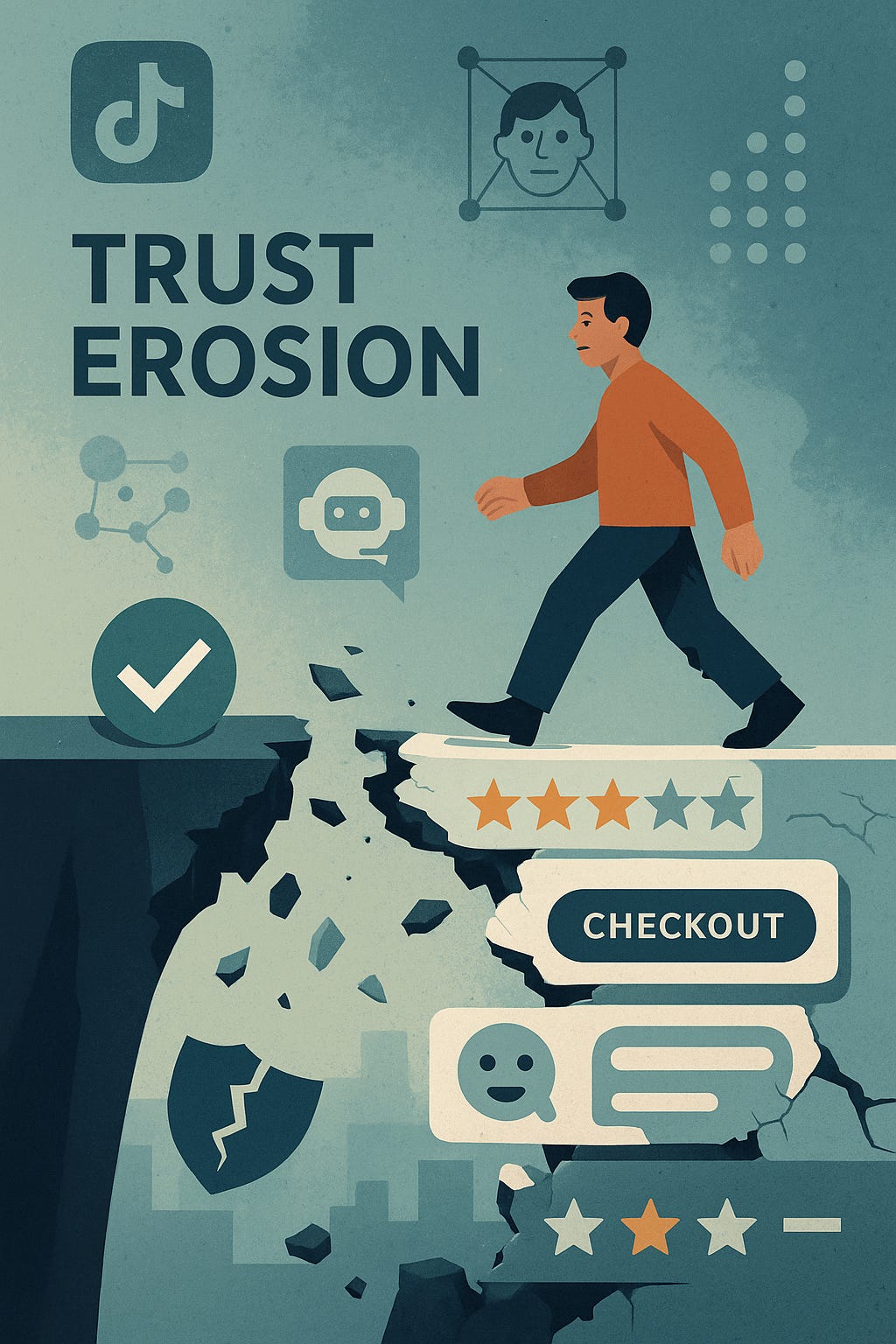Trust, Interrupted: The Slow Leak
Trust isn't lost all at once, it's drained by dark patterns, friction, and manipulation. Learn how micro-betrayals destroy digital confidence over time.
The Slow Leak: How Trust Erodes in Digital Environments
Trust rarely vanishes in a moment.
It leaks. Quietly. Invisibly. Often irrevocably.
In the late 1990s, we conducted a deep dive into e-commerce friction, over 600 distinct barriers to completing a transaction. We didn’t know it then, but we were documenting the early architecture of digital distrust.
Those obstacles, unclear CTAs, broken form logic, and manipulative upsells weren’t just design failures. They were micro-breaches of psychological safety. They taught the buyer to hesitate, second-guess, and assume the worst.
Today, the stakes are higher, the systems are smarter, and the betrayal is smoother.
Let’s talk about the dark side of design.
Death by a Thousand Micro-Betrayals
The erosion of trust in digital environments doesn’t usually happen with a data breach or an egregious scandal. It happens when:
A discount code doesn’t work at checkout.
A “support agent” turns out to be a lobotomized chatbot.
A return policy feels like a trapdoor clause.
A homepage features products you just whispered about near your phone.
Each of these is a micro-betrayal. Alone, it might seem like a hiccup. Together, they become a pattern, a drip-drip-drip that signals:
“This system isn’t here for you. It’s here to get something from you.”
And once the pattern is felt, trust calcifies, and it’s not in your favor.
UX Sins That Corrode Credibility
The most dangerous UX sins aren’t loud. They’re strategic. Designed to pass under the radar of regulation, user awareness, or even team accountability.
1. Dark Patterns (by Design, Not Accident)
Hidden unsubscribe links.
Auto-check boxes.
Countdown timers that reset.
These aren't poor design decisions. They're calculated trust withdrawals dressed as optimization.
2. Friction As Gatekeeping
Some friction is protective. Most is just obfuscation, designed to wear you down.
Complex account deletion flows.
Mandatory sign-ins for trivial actions.
Requiring chat with an agent to cancel.
This isn’t just annoying. It tells the user that we don’t trust them but expect their trust in return.
3. Manipulative Personalization
AI-enhanced personalization can delight, but when it veers into emotional engineering, it crosses the trust line:
Algorithmic pricing shifts based on perceived urgency.
Content tuned to fear, scarcity, or envy.
Recommenders are exploiting psychological weak points.
The more “personal” it feels, the more suspicious users become, especially when they don’t know why something is being shown.
Trust Breakdown Vectors: Reframing the 600 Obstacles
If I reclassified that original ecommerce study today, I’d label each obstacle as a trust breakdown vector. Here are just a few:
Trust doesn’t collapse all at once.
It accumulates debt until one small failure becomes the last straw.
The Unseen Damage: Invisible Abandonment
The most haunting part of trust erosion? You often never know it happened.
No angry customer. No tweet. No refund request.
Just silence. Exit. Ghosting.
The user closes the tab and never returns, not because of one big betrayal, but because the emotional math no longer adds up.
They felt watched when they wanted privacy.
They felt coerced when they needed autonomy.
They felt tricked when they wanted help.
Trust erosion is emotional dissonance at scale. You don’t notice the tipping point, but you feel the churn, the bounce rate, the “weird drop in conversions.”
The Long-Term Cost of Trust Abuse
Dark patterns may bump conversion this week. But they plant distrust antibodies in your user base.
Each betrayal:
Increases the user’s cognitive load.
Weakens brand memory.
Conditions suspicion across future interactions.
And critically, it doesn’t just affect you. It radiates outward. When your platform burns trust, it lowers the baseline for your entire category.
This is how industries collapse into zero-trust systems. Think healthcare portals, airline refund processes, and subscription management.
Every betrayal becomes someone else's problem to clean up, until no one believes anyone anymore.
Let’s Call It: UX Is Moral Infrastructure
If trust is the currency of modern interaction, UX is the mint.
Every interface, every flow, every tooltip, and delay timer is an opportunity to signal:
“You’re safe here.”
“We’ve designed this with your agency in mind.”
“We don’t just want your money. We want your confidence.”
Or not.
Coming Next:
“TikTok Shops and the Mirage of Intimacy”
How para-social trust seduces modern buyers, and what happens when the illusion breaks.



